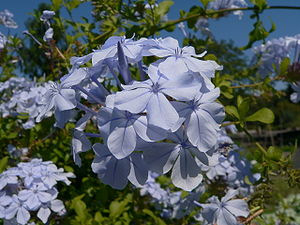Cape leadroot
| Cape leadroot | ||||||||||||
|---|---|---|---|---|---|---|---|---|---|---|---|---|

Cape leadwort ( Plumbago auriculata ), flowers |
||||||||||||
| Systematics | ||||||||||||
|
||||||||||||
| Scientific name | ||||||||||||
| Plumbago auriculata | ||||||||||||
| Lam. |
The Cape plumbago ( Plumbago auriculata , Syn. : Plumbago capensis Thunb.) Is a South African plant of the genus Plumbago ( Plumbago ), which today worldwide as an ornamental plant spread has found.
description
The Cape leadwort is a shrub about 2 to 4 m high . Its branches are prostrate to overhanging or climbing. The light green, alternate, entire, short-stalked leaves are 3 to 9 cm long and 1 to 3 cm wide. The leaf stalks are winged like an auricle at the base (hence the scientific species name auriculata ). On the underside of the leaf there are numerous small, whitish scales that are created by glands that deposit lime (protection against evaporation).
The light blue flowers appear mainly in summer and are in terminal, somewhat one-sided spikes . From the tubular calyx , which is covered with stalked, sticky glands, protrude the petals with a long, narrow tube and five-part, flat hem.
The fruit is a five-lobed capsule.
Distribution and ecology
The Cape leadwort comes from South Africa . Their distribution area extends from the southern Cape region to Eastern Cape and KwaZulu-Natal . It can also be found in Gauteng and the adjacent areas of Free State and the North West Province . There is also an isolated occurrence in Mpumalanga .
Typically the species grows in bushes or thickets. The flowering plant is visited by various butterflies. Their leaves serve as food for the caterpillar of Cyclyrius pirithous .

Conversely, the sticky sepals sometimes catch animals up to the size of a housefly. It is believed that the plumbago species living today are very similar to the first ancestors of Drosera and other carnivorous plants.
As an ornamental plant, Plumbago auriculata is widespread today in the tropics and subtropics (including the Mediterranean region). It is also cultivated as a container plant in Central Europe (often as a high trunk ), but is not frost hardy.
sorts
There are several types , including a. 'Royal Cape' (blooms in a darker blue) and the white-flowered and lower-growing 'Alba'.
use
In the home of the plant, its pressed juice, which turns the skin blue-gray, is used for tattoos .
source
- Andreas Bärtels: Color Atlas of Tropical Plants . Ulmer, Stuttgart 1989, ISBN 3-8001-3448-9 .
- WJ Beal: Carnivorous Plants . In: American Naturalist . tape 10 , 1876, ISSN 0003-0147 , p. 588-591 .
- Jan Schlauer: “New” data relating to the evolution and phylogeny of some carnivorous plant families . In: Carnivorous Plant Newsletter . tape 26 , 1997, ISSN 0190-9215 , p. 34-38 .
